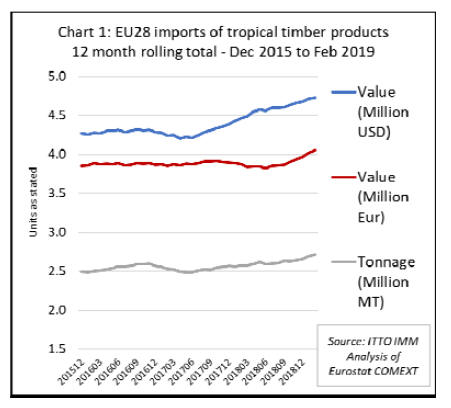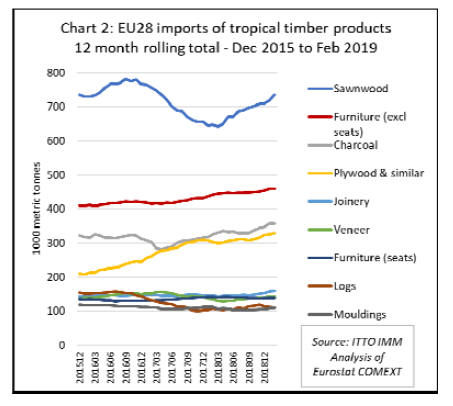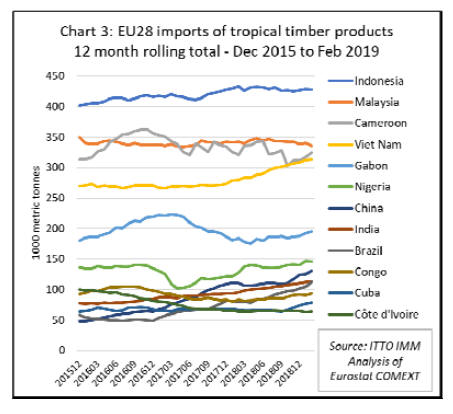|
Report from
Europe
EU tropical timber imports rising since
mid-2018
ITTO¡¯s analysis of Eurostat year-end data showed that the
total value of tropical wood imports into the EU increased
slightly in 2018, although at a slower rate than imports
from non-tropical countries tropical wood continued to
lose share last year (ITTO MIS Volume 23 Number 4 16-
28 February 2019).
Closer analysis of monthly data to end February 2019
reveals a slightly more positive picture, showing that EU
imports of tropical timber products began to rise more
strongly, both in quantity and value terms, in the second
half of 2018.
EU imports began to rise earlier, from the start of 2017, in
dollar terms as the euro strengthened significantly against
the US currency between December 2016 and February
2018 (Chart 1).

The rise in EU imports of tropical timber in the second
half of 2018 and the first quarter of 2019 was driven by
several products groups. EU imports of tropical
sawnwood, which have been highly volatile in recent
years, regained ground lost during the slump in the second
half of 2017.
EU imports of wood furniture (excluding seating) from
tropical countries have been rising slowly and consistently
since the start of 2017, driven by Vietnam and India.
Imports of tropical charcoal and plywood have also been
rising during this period. Most tropical charcoal is derived
from Nigeria and Cuba. The rise in tropical hardwood
plywood imports is concentrated in product from China
and Indonesia, the latter partly boosted by FLEGT
licensing. (Chart 2).

While imports of plywood from Indonesia have been
rising, EU imports from Indonesia across all product
groups were flat in 2018 and have remained so in 2019. So
too have imports from Malaysia.
EU imports from Cameroon have been extremely volatile
in recent times, with the overall trend downward.
However, there was a slight uptick in imports from
Cameroon at the start of 2019.
EU imports from Vietnam, nearly all furniture have been
rising steeply since the start of 2018 and this trend
continued into the New Year. After a long period of very
slow trade, EU imports from Brazil, mainly of decking,
have been recovering in the last six months. (Chart 3).

Imports vary widely between member states
Trends in tropical timber imports tend to vary widely at
national level, although the latest upturn in imports has
been quite well distributed across the EU. Of the largest
destination countries, only Germany registered a decline in
direct trade of tropical timber at the start of this year (and
as noted in the last issue of ITTO MIS, a feature of
Germany¡¯s trade in tropical timber is that most is now
sourced indirectly from other EU countries).
Imports increased sharply into the UK in the opening
months of 2019 and were also rising in Belgium, France,
Netherlands, Spain, Portugal, Greece and Poland. Imports
remained flat in Italy however (Chart 4).

The recent upturn in tropical timber imports is rather
surprising as, to a large extent, it is against broader
economic trends in the EU. The value of the euro and the
British pound eased against the dollar in 2018 and remain
at historically low levels, acting as a drag on imports.
EU domestic demand still buoyant
According to the EU¡¯s Spring 2019 Economic Forecast,
issued on 8th May, ¡°economic activity in the EU slowed
further in the second half of 2018 as growth in the global
economy and trade weakened amid tightened global
financing conditions, unresolved trade tensions, high
uncertainty, and as a result of exceptional weakness in the
manufacturing sector that extended into the start of 2019.¡±
The Forecast identifies a wide range of factors that
¡°weighed on sentiment¡± in the EU, including ¡°disruptions
in the car manufacturing sector, social tensions, policy
uncertainty, as well as uncertainty related to Brexit.¡±
Overall, GDP growth in the EU is forecast to moderate
from 2.1% in 2018, to 1.4% this year and to remain at this
lower level in 2020.
On the other hand, according to the Forecast, ¡°domestic
demand has been less affected. Employment growth,
which has so far remained resilient, is expected to
continue in the euro area, but at a slower pace.
Combined with rising wages, muted inflation and
supportive fiscal measures in some Member States, job
creation should continue to underpin household spending
this year and next. At the same time, low financing costs
should help to at least partly offset the negative impact of
lower sales expectations on investment¡±.
The relative resilience of domestic demand goes some way
towards explaining the rise in tropical timber imports in
the EU in recent months. It has been enough to encourage
importers that have been holding stocks at relatively low
levels for many months back into the market.
Equally, some cooling in global demand against the
background of slowing economic growth in China and the
trade dispute with the US, has made international prices
for hardwood products more attractive to European
buyers. The growing global competitiveness of Vietnam
and India is also becoming more evident as these countries
are increasing penetration of the EU wood furniture
market.
The particularly strong growth in the UK market in the
opening months of 2019 is surprising given the high levels
of uncertainty in the UK economy created by Brexit.
Both new construction and building renovation markets,
the latter being critical for hardwoods, were slowing at the
end of 2018. The UK economy appears to have grown
weakly in the first quarter of 2019, with the services and
manufacturing purchasing managers index hovering only
slightly in expansionary territory amid soft new orders.
Latest surveys from the Construction Products Association
(CPA) and Federation of Master Builders (FMB) are
slightly more positive. The CPA¡¯s State of Trade Survey
for the first quarter 2019 shows continued growth in UK
sales of construction products and materials, while the
FMB¡¯s survey demonstrates better expectations for small
and medium sized builders.
However, the surveys also indicate that the political and
economic situation is holding back product manufacturers¡¯
capital investment in the UK, particularly in commercial
offices, industrial factories and high-end residential.
Feedback from the UK hardwood trade indicates that
buying remains quite cautious, although trade data
suggests some importers may have carried out stockpiling
in the weeks immediately before 29 March 2019, the
original date of UK departure from the EU. It may be that
imports tailed off in March and April after the decision to
delay the official Brexit date until 31 October.
The growth in Belgium tropical timber imports this year is
driven mainly by sawn timber and decking products and
mainly reflects Belgium¡¯s key role as a distributor of
tropical timber to other parts of the EU. This has become
more pronounced with the move to Just-in-Time
purchasing and EUTR implementation which discourages
manufacturers and smaller distributors from direct imports
from the tropics.
Prospects for consumption of tropical hardwood within
Belgium itself are not promising. There was sluggish but
stable economic growth in Belgium last year but
household spending is falling with declining consumer
confidence. Economic sentiment is falling in the run-up to
federal elections in May.
The market in France is turning around slowly after
several years of stagnation. Fourth-quarter GDP growth
was modest but resilient, stable from a quarter earlier
despite the social unrest of last year¡¯s ¡®gilets jaunes¡¯
protests.
Domestic demand was hit by the demonstrations, with a
decline in household spending. Market sentiment was
improving in France in the first quarter of this year and
fiscal policy is helping to prop up private consumption.
However, growth is likely to be constrained against the
backdrop of global trade tensions and lingering Brexitrelated
uncertainty.
The Italian market remains subdued and is still adjusting
to the long-term effects of the economic crisis of a decade
ago, with fewer manufacturers processing a narrower
range of species and fierce competition for business.
The bigger hardwood importers and distributors now
favour smaller just in time ordering, as end users try and
keep stock to a minimum and order only what they
immediately need to process.
The Italian economy continues to struggle weighed down
weak domestic demand which is driving down industrial
output and sales and contributing to low business
confidence. As for households, worsening consumer
confidence and a deterioration in the labour market point
to subdued spending patterns.
In other news, the Italian government endorsed China¡¯s
Belt and Road Initiative in late March, in the hope of
receiving substantial infrastructure financing.
Spain¡¯s hardwood market dipped after the summer break
in 2018 with importers blaming instability both internally
and externally.
At home, the issue of independence for Catalonia has not
gone away, state budgets are not approved and indecision
about potential new mortgage taxes affected investment in
the housing sector. Generally, importers have reacted by
maintaining stock at low levels and buying only essential
items on a ¡°just in time¡± basis.
However, there are also positive signs in Spain. Industrial
production rebounded solidly in January and the services
sector is stable. Private consumption is quite solid,
propped up by healthy employment growth and higher
purchasing power thanks to low inflation. There was a
slight upturn in Spain¡¯s imports of tropical products at the
end of 2018 and in the first two months of 2019.
The Netherlands still stands out as a growth area for the
EU market. In the final quarter of last year, the Dutch
economy accelerated on the back of firming domestic
demand and an improved trade balance.
Economic growth is expected to moderate in the
Netherlands during 2019 as the external environment
becomes more challenging, but domestic demand should
remain robust on the back of fiscally expansionary
policies.
Turnover in the Dutch construction sector increased 10%
to a 10-year high last year. The total number of new home
starts was stable, with 70,000 building permits issued, the
same as in 2017. That is some way below pre-crisis levels,
when around 80,000 new permits were given every year,
but still implies good levels of consumption this year in
the finishing sectors important to hardwoods.
|